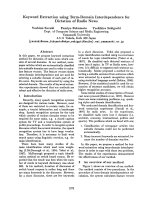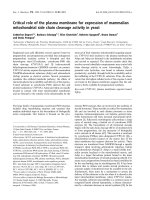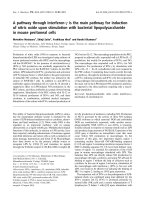Using the NDVI differencing for mapping of Dipterocarp forest in Savanaket Province, LAO PDR
Bạn đang xem bản rút gọn của tài liệu. Xem và tải ngay bản đầy đủ của tài liệu tại đây (809.24 KB, 7 trang )
USING THE NDVI DIFFERENCING FOR MAPPING OF DIPTEROCARP FOREST
IN SAVANAKET PROVINCE, LAO PDR
Nguyen Ngọc Thach1, Le Thi Khanh Hoa1, Virany SENGTIANTHR1, Pham Xuan Canh1, Pham Viet Hong2
1
Faculty of Geography, VNU University of Science, 334 Nguyen Trai Str, Thanh Xuan, Ha Noi, Vietnam
2
Institute of marine geology and geophysics, Vietnam Academy of Science and Technology
Email:
KEY WORLDS: Diterocarp forest, Landsat image, Dry season, Rainy season, difference NDVI, Mapping.
ABTRACT: A dipterocarp forest is a dominal type of forest native in Lao PDR, it include Dipterocarpacaeae tree
family, which are tall and are known to produce resins and timber with good quality. It is a tipical type of
deiduous forest, formed various landscape and ecological system in Lao, especially the elephant ecosystem.
Mapping and monitoring of Diterocarp forest is the purpose of the study. Data used is the Landsat image taken in
dry season (January) and wet season (August). In the image of dry season, the forest ares is looked as the bareland
because trees sheding all of their leaves. Inversely with this, in rainly season, the Diterocarp forest area is looked
as the evegreen forest because leaves of trees are ground up with very high canopy index. The NDVI image had
been used for determination of the forest areas and then, the NDVI differenced image between two seasons has
been used for determination of the Diterocarp forest,where having high diference of the NDVI values are the
Diterocarp forest areas.
Dending on the threshold of the diference NDVI valus and comparision with other GIS data such as
DEM and morphological features, the Diterocarp forest map has been established with differenced type such as
homogenous Diterocarp forest, Diterocarp forest mixed with evegreen forest, Diterocarp forest mixed with rice
cultivated plant, Diterocarp forest mixed with bush and grass…The map has been checked with high accuracy.
1. General introduction
Dipterocarp forest is located in the region with tropical climate such as India, Southeast Asian countries such as
Indonesia, Philippines, Malaysia, Thailand, Cambodia, Laos, Vietnam. In Laos, Dipterocarp forest is a type of
specific forest appearing in many places, not only in Savanakhet province including 6 earthly branches and 27
species [11]. In, Vietnam great area of Dipterocarp forest is focused in the Central Highlands.
Dipterocarp forest (Dipterocarp) is a type of forest with plant species under Dipterocarpaceae family prevailing.
This is a type of thin and clear forest, it is often located in the regions with climate distinguished into two clear
seasons: rainy season - dry season. Forming from tree species with unclosed shade, leaves are fallen in a long
period of time. The forest has only one layer, there is often no lower layer, fresh carpet is mainly grass.
Dipterocarp forest often occupies separate areas with some tree species having absolute component coefficient in
which they are mainly tree species under Dipterocarpaceae family, besides some trees under Dipterocarpaceae
family, there are some other types of wood but the rate is less [1,2,3,4,7,8,10,11,12].
The plant system area of Dipterocarp forest is related to the plant system of Malysia - Indonesia with plant species
of Dipterocarpaceae family prevail. The region of plant system of Dipterocarp forest includes 309 tree species
under 204 earthly branches, 68 families, in which there are over 90 wood tree species with 54 big wood and
normal wood tree species [7].
By remote sensing and GIS method, the subject “Application of remote sensing and GIS in researching
Dipterocarp forest in Savanakhet, Lao People’s Democratic Republic” was selected for researching Dipterocarp
forest in Savanakhet, step by step identifying the object of Dipterocarp forest on remote sensing image, supporting
to overcome the difficulty in interpreting on the image, at the same time, determining the distribution rule of
Dipterocarp forest according to the topographical stratification. The research area is 5 districts of Savanakhet
namely M. Thapanthong, M. Songkhon, M. Xonbouli, M.Champhon and M. Atsaphangthong.
2. Overview of research area
With geographical coordinates from 15053’ to 17008’ North latitude, 104044’ to 106057’ East longitude, Natural
area of the province is 21,774 km2, Savanakhet is a province in the Center of Laos, has big forest resource.
Savannakhet is a province with rather diversified topography and can be classified into three big areas: Delta area
on the East bank of Mekong river with rather dense rivers and streams system, it is main agriculture production
area of the province as well as of Laos; Highland area is rather flat, there are much potential for planting industrial
trees; Vietnam Laos border mountainous area is preserved forest region. whole area had forest coverage of 70 %
(MAF, 2001) with many specific forest ecological systems such as: Evergreen forest, Mixed deciduous forest,
Bamboo forest, Unstocked forest… in which, Dipterocarps forest is one of important natural objects of the forest
ecological system of Laos in general and Savanakhet province in general, accounting for a considerable area in
total natural forest area, this is forest type which is plentiful in resource, diversified in biology, at the same time, it
brings many high economic values such as wood exploitation and processing, oil production…, especially
Dipterocarp forest is also the living place of many precious and rare animals such as elephant, deer, muntjac,
bull… this thing created an unique, rare ecological system of Dipterocarp forest in Savanakhet. However, this area
does not have much research database relating to this important forest object; therefore, there are many difficulties
in research about ecological feature, classification as well as distribution of Dipterocarp forest in the province
[12].
Figure 1. Administrative map of Savanakhet province and research area
3. Research method
3.1. Scientific conception
Dipterocarp forest develops well on “ground” of monsoon tropical climate; there is no cold winter but there is a
typical dry season. Total annual thermal accumulation is from 7,500 - 9,0000C. Annual average air temperature is
from 210C - 27 0C. High air temperature is below 400C. Low air temperature is not below 100C.
Annual average rainfall is from 1,200 - 1,800 mm. The wet rainy regime is very severe. The climate has two clear
seasons. The rainy season is from May to October, the rainfall accounts for 90% total rainfall of the whole year.
The severe dry season lasts from November to April of following year. Every year, there are 4 - 6 dry months, 1 2 moderately dry months, 1 extremely dry month. The flooded regime in rainy season is one of the decisive
factors participating in the process of arising Dipterocarp forest. Other types of normal green tree do not adapt to
flooded condition, they cannot live jointly with tree species of Dipterocarp forest.
Hydrological condition also affects to water regime of Dipterocarp forest. In dry season, surface water and
underground water in Dipterocarp forest is very drought. River and mountain system in highlands is not as many
as that in delta. In rainy season, rain focuses and causes flood, it forms different types of Dipterocarp forest.
Annual average air humidity is 80 - 85%, in dry season, the air humidity is only 72 -73%.
Soil of Dipterocarp forest is bad, it is located on types of soil such as: Bony soil on clays sandstone source rock,
Feralit light yellow soil on sandstone source rock, silica, rhyolite, exhausted grey soil on ancient alluvial soil, grey
exhausted alluvial soil, exhausted grey soil on slope product, red basaltic soil of thin soil layer. Depending on
each type of soil, there are prevailing communities.
Because of a character of defoliation of this short of forest, in the dry season, Dipterocarp forest is falling leaves
and then the rainy season comes, it shall become green again. This is the cause of the interruption in the remote
sensing image for this short of forest, it is mistaken for other objects. In the remote sensing image taken in the dry
season when Dipterocarp forest was falling leaves, it is mistaken for unoccupied soil or water surface… and in the
rainy season, when Dipterocarp forest was still green, Dipterocarp trees grew among the evergreen forest or they
grew among the rice, it is mistaken (figure 4). Image Lansat 8 was taken on 1/3/2014 (dry season) and on
8/8/2013(rainy season) for the study.
Figure 2. ImageLansat 8 taken in the dry season (left image) and in the rainy season (right image)
Season for
receiving
Sample in Landsat 8 image
Field picture
Rainy season
Drain season
Figure 3. Sample photo of Dipterocarp forest in photoLansat 8 in rainy season and dry season.
In the dry season, Dipterocarp trees are falling their leaves,these objects have low NDVI index and whereas, in the
rainy season, Dipterocarp forest is green and growing and NDVI index shall be high. For this season, the objects
in the image have big difference of NDVI between the rainy season and the dry season, it shows that it is
Dipterocarp forest, for other objects, because there is no a character of defoliation by season like Dipterocarp
forest such as bamboo forest, evergreen forest, grassland….the value difference of NDVI between two season
shall be low or untangle. Base on such difference, we can use NDVI to identify and separate Dipterocarp forest
from other objects in the remote sensing image and can not be mistaken Dipterocarp forest for other objects in the
imaging diagnosis.
3.2. Research process
Data used for the study are Landsat 8 images and related database, remote sensing method uses NDVI index as
main information for discriminating Dipterocarp forest, in addition, it uses wet index of surface to determine the
wet regime of soil. The following is diagram showing the research process.
Figure 4. Diagram of research process
From the image data collected at the study area after passing the imaging processing steps, including geometric
correction and increasing image quality, the NDVI index of the image shall be calculated for two seasons: Dry
season (NDVI1) and rainy season (NDVI2), because leaves are falling by seasons of the Dipterocarp forest, if it is
Dipterocarp, NDVI of two seasons shall be very different, in the rainy season, NDVI shall be high and in the dry
season, it shall be very low, hence, objects for value difference of two seasons (NDVI2-NDV1) are big (NDVI
difference threshold is determined), such objectives are Dipterocarp forest, and others giving low or unchangeable
value difference shall beloing to other objects such as unoccupied soil, water surface, evergreen forest… Having
divided shorts of Dipterocarp forest into Dipterocarp with rice, Dipterocarp in water surface, pure Dipterocarp… a
map of shorts of Dipterocarp is prepared from these results.
Calculation of NDVI index in the dry season:
NDVI = (Band 5 - Band 4)/(Band 5+Band 4)
Figure 5. Map of NDVI index calculation in the dry season (left) and rainy season (righ)
From the result of NDVI of two seasons, calculation of NDVI difference between two seasons:
T= NDVI2 - NDVI1
Figure 6 Map of NDVI difference and spectrum diagram of two seasons
The steps of calculation given above are processed in ENVI software, the result is difference of NDVI. By ArcGis
software, thanks to the tools in Arcgis, carry out dividing the NDVI threshold into Dipterocarp forest layer, the
higher the objects with NDVI conferencing is, the more Dipterocarp these objects are, because just Dipterocarp
has a character of defoliation by season, NDVI plant index shall be very different between two seasons if such
object is Dipterocarp. Map with two layers of objects, namely Dipterocarp and layer of other objects was created .
The study found out the relative variance threshold of NDVI of the distribution of Dipterocarp forest within
(0.186938 - 0.56636). We can sea that the area of Dipterocarp forest mainly gathers in all of 5 districts.
3.3. Results of the study
3.3.1. Separation of Dipterocarp forest types
This is a short of Dipterocarp growing at the depressions or wet soil, to separate this layer of Dipterocarp forest,
the study used some differences of MNDVI (Modified Normalized Difference Water Index). This index was
used as a separator to divide the soil layer from water layer.
MNDWI
Besides, the landuse data was used for classifying distribution of Dipterocarp forest ( fig.7)
Figure 7. Dipterocarp forest map and distribution on water and rice fields
3.3.2. Establishment of distribution map of shorts of Dipterocarp
Thanks to the support tools of GIS, stack layers of map data as processed above, the study established a
distribution map of shorts of Dipterocarp, including 4 layers of objects, namely: Dipterocarp growing among rice,
Dipterocarp growing on the water, pure Dipterocarp and layer of other objects:
3.4. Verification of accuracy of object classification
Because of shortage of condition and time for field survey, to verify the result of map classification of the shorts
of Dipterocarp above, the study evaluated the reliability by KAPPA index (Cohen-1960)
The study selected the method of simple random sample because this is an advantageous one, for each layer of
objects, they have same probability to be selected in full set of samples. According to Russell G. Congalton
(1986)[13], for each layer of objects, maximum points to be taken randomly are 30. With for 4 layers of objects,
we shall have 120 points to be taken randomly in total.
Figure 8. Distribution map of points to be taken randomly for verification
To verify the accuracy of these 120 random points, the study checked the accuracy by the field survey and
comparison with the map of land use.
From the results from the comparison of points to be taken randomly, the study obtained table of variance matrix
(Table 2)
Table 2. Variance matrix of image classification from field sample
Actuality
Pure
Dipterocarp
Classification
Pure
26
Dipterocarp
Dipterocarp
growing
3
among rice
Dipterocarp
1
on the water
Other
2
Total
32
Overall accuracy (K)
Dipterocarp
growing
among rice
Dipterocarp
on
the
water
Other
Total
Relative
accuracy
1
0
3
30
86.67%
24
1
2
30
80%
7
19
4
30
63.33%
1
33
1
21
68.9%
25
34
30
92
83.33%
With K = 0.689, according to kappa assessment scale, it has good classification.
4. Introduction to analysis of distribution rule of Dipterocarp forest
The study started to determine the distribution of Dipterocarp forest in 5 districts of study. Basing on the
topographical level, the study conducted to create DEM, layer the topographical level for the study area, then, we
can see that the lowest level at this area is 130m and highest level is >1200m, however, the popular topographical
level at here is between 130 - 250 m.
Figure 9. DEM map and distribution of Dipterocarp forest by elevation and short of soil
Figure 10. Diagram of area distribution rate of Dipterocarp forest by level
Basing on the diagram, we can see that Dipterocarp forest here mainly distributes at level between 130 - 250 m, in
which, it distributes at level between 150 - 250 m with >54%. At higher level, Dipterocarp forest distributes with
small area, from level >500m, it seems that Dipterocarp forest can not survive at this level. Then we can see that,
at level between 130 - 250m, it has good condition of climate, weather, rainfall or soild for this short of
Dipterocarp forest to develop and grown well.
Soil of Dipterocarp forest distributes on shorts of soil such as: Bony soil on clays sandstone source rock, Feralit
light yellow soil on sandstone source rock, silica, rhyolite, exhausted grey soil on ancient alluvial soil, grey
exhausted alluvial soil, exhausted grey soil on slope product.
CONCLUSION
From the Landsat data of two season, combined with the remote sensing method and GIS, the Dipterocarp forest
can be established with high accuracy. From the map of NDVI differencing threshold for distribution maps of
shorts of Dipterocarp forest and distribution maps of shorts of Dipterocarp forest by level, short of soil for 5
districts of study, namely M. Thapanthong, M. Songkhon, M. Xonbouli, M. Champhon, M. Atsaphangthong of
Savanakhet, Lao PDR.
Using NDVI index to identify object of Dipterocarp forest is a new trend of study, hence, it shall need much time
to have deep study in the future to gain higher accuracy than visual interpretation or classification of pixel
spectrum.To have accurate result, it requires that the remote sensing data resource to be used must assure the
quality and time of receipt. In terms of quality, the data must be received and processed to avoid interference,
especially static. In terms of time, these images represent for rainy season (October) and dry season (February).
Acknowledgment:We would like to thank National University of Viet nam ( VNU ) Ha Noi,University of
science for providing partial finalcial assistance to us for attending the 35 Asian Conference on Remote Sensing
2014.
REFERENCES
1. Ministry of Agriculture and Rural Development, Handbook of forestry sector - Vietnam natural forest
ecosystem. 2006.
2. Nguyen Van Truong, Determining reserves of carbon of Dipterocarp forest in Gia Lai provicne. 2012,
Master’s thesis in Environmental science - Hanoi of Science, VNU Hanoi
3. Vu Duc Quynh - Vi Xuyen forest management unit - Ha Giang, Result of Dipterocarp forest biomass
study in Central highlands, Forestry Science Journal (2882 - 2890). 3/2013.
4. Nguyen Dinh Hoe, Pham Duc Tu, Living on Dipterocarp forest in Vietnam. 2013.
5. Nguyen Ngoc Thach, Remote sensing fundamentals 2005: VNU Hanoi Publishing House
6.
7.
8.
9.
10.
11.
12.
13.
Nguyen Ngoc Thach, Nguyen Dinh Hoe, Remote sensing in natural resource and envionmental study.
1997: Technical Science Publishing House.
Pham Dung, Central Highlands Dipterocarp forest - An unlimited treasury, People’s Newspaper No.
16825. 09-08-2001.
Tem Smitinand, The Distribution of Dipterocarpaceae in Thailand. 1966
Gerhard Langenberger, Habitat distribution of dipterocarp species in the Leyte Cordillera: an indicator
for species – site suitability in local reforestation programs. 2005, Institute of Plant Production and
Agroecology in the Tropics and Subtropics, University of Hohenheim, Germany
Prasad P.Rama Chandra, Ecological analysis of dipterocarpaceae of North Andaman forest, India. 2011
Chanhsamone Phongoudom and Khamfeua Sirivongs, The role and development status of
Dipterocarpaceae Family in Lao PDR. 2006
Hanqiu Xu, Modification of normalised difference water index (NDWI) to enhanceopen water features in
remotely sensed imagery. 2006
Russell G. Congalton (1991), A Review of Assessing the Accuracy of Classifications of Remotely Sensed
Data, Department of Forestry and Resource Management, University of California, Berkeley.









